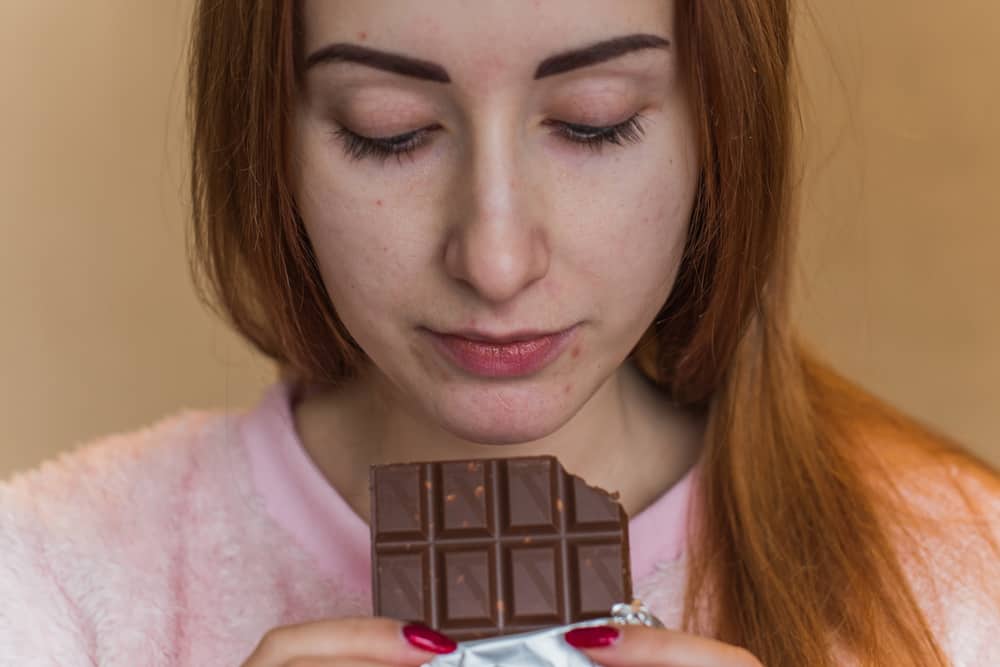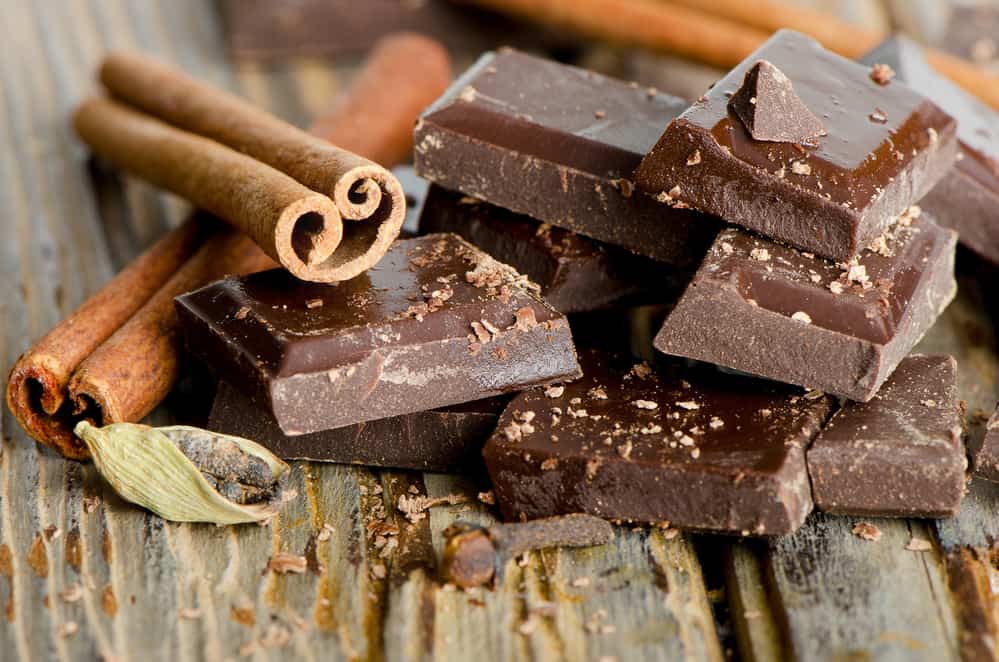If you have acne or acne-prone skin, you must be extra cautious about your food intake, as poor dietary habits can aggravate acne.
Chocolate consumption has long been blamed as a contributing factor.
A lot of research has been done to determine how much chocolate is to blame and what ingredients cause skin breakouts.
Eating chocolate causes the immune system to become more aggressive in its response to the bacteria that causes acne.
Another study found that those who ate chocolate developed skin breakouts 48 hours after eating it, whereas those who ate jelly beans as an alternative did not.
5 Reasons Why Chocolate Causes Acne
1. Sugar
Because chocolate is sweet, it causes acne. We all enjoy anything sweet, whether it’s a pie or a chocolate bar. However, sugar is bad for our skin, especially sensitive skin.
The two major causes of acne are hormones and inflammation, and sugar affects both of them. Our blood sugar level rises when we consume carbohydrates such as white sugar.
In response, the pancreas releases insulin. If you experience acne, you should understand that inflammation is the end-all and be-all of acne production.
Acne thrives in an environment of inflammation, bacteria, and oily skin (which is also caused by sugar).
According to dermatologists, those who consume more sugar are more prone to acne than those who do not. As a result, sweetened chocolate is not your friend.
Further reading: check out our write-up on inflammatory acne and how you should cut sugar.
2. Fats/Butter
Dairy products are considered enemies of acne-prone skin. Although not everyone is sensitive to fats or butter, it can cause acne in many people.
Some chocolates contain butter, so you should check the ingredients before purchasing them if you are allergic to butter.
It is thought that butter and other fats increase oil production in the skin, which leads to blocked pores. Blackheads and breakouts are caused by clogged pores.
Excessive oil on the skin harbors bacteria that can easily lead to acne formation because it provides a favorable environment for such bacteria to grow.
Furthermore, the bacteria in butter can irritate your sensitive skin.
3. Milk
We all enjoy milk chocolate, and I believe we prefer it to dark chocolate. However, the milk in your chocolate could be one of the causes of your acne.
Cow milk may contain harmful ingredients added to increase milk production. These animals are frequently subjected to artificial hormones.
The research suggests that these hormones may disturb your hormonal levels if you consume the milk coming from the affected cow.
Dermatologists believe that milk drinkers have more acne than non-milk drinkers.
Another study showed that total milk consumption was related to the occurrence of acne; this includes milk with any fat content.
It makes no difference if only 1 percent fat milk is used; it could be just as harmful as any milk with higher fat content. This is why products that contain milk and chocolate, like Nutella, can trigger acne breakouts in lots of people.
Further reading: check out our write-up on dairy’s impact on acne. An alternative is to drink almond milk, which is great for acne.
4. Nuts
Any chocolate becomes more delectable when it contains nuts. But, once again, these delectable nuts come at the expense of your skin’s beauty.
Almonds and cashews are rich in omega-3 and omega-5 essential fatty acids. These acids are beneficial to your health, but they can also be harmful to your skin.
Moreover, some nuts contain omega-6 acids that are more inflammatory than others.
If the ratio between omega-3 and omega-6 acids is not balanced and more omega-6 acids are consumed, they may trigger redness of the skin and inflammation.
Peanuts, for example, are high in omega-6 fatty acids. Acne sufferers who consume chocolates containing nuts may experience an increase in the number of pimples on their faces.
Further reading: read this write-up on the impact of nuts on acne for more details.
5. Caffeine
Another common ingredient found in most chocolates is caffeine. If an acne-prone person avoids tea and coffee but still gets a lot of acne, he should limit his chocolate intake.
Caffeine is now added to many chocolate brands during the manufacturing process. Caffeine may disrupt your sleep cycle if you consume a lot of it.
Less sleep means more awake time, which naturally leads to increased stress.
Cortisol, a stress hormone, stimulates oil production in the skin via the sebaceous glands.
If caffeine causes skin breakouts, you must filter all products that may contain caffeine, such as chocolate. This could lead to acne production, worsening the condition if you already have it.
3 Ways How To Enjoy Chocolate without Getting Acne
1. Eat Chocolates Low in Omega-6 Acids
If you are a chocolate fan who can’t stop eating chocolate, make sure to read the ingredients. Avoid purchasing chocolates that contain an excessive amount of omega-6 fatty acids.
They are bad for your skin. Similarly, chocolates containing peanuts should be avoided. Instead, look for chocolate with a higher proportion of omega-3 acids than omega-6 acids.
For example, nuts like walnuts and pistachios are rich in omega-3 acids. Omega-6 fatty acids stimulate the production of oil as well as inflammation.
Omega-3 fatty acids protect the skin from inflammation. Chocolate lovers should be aware of this fact, as not having acne in recent times doesn’t ensure that you will never have acne again.
Consumption or the use of the incorrect food product can set it off.
2. Caffeine-Free Chocolate
Caffeine consumption can set off a chain reaction of acne and side effects, ranging from less sleep to increased stress to elevated cortisol levels and increased skin breakout.
If you absolutely must have chocolate, choose caffeine-free varieties. Some researchers have shown caffeine to increase happiness and energy.
However, if consumed in excess, this beneficial ingredient can become your skin’s enemy. Caffeine stimulates the sebaceous glands in the skin, causing them to produce more oil.
Excess oil on the skin makes it extremely sensitive and traps dirt in the pores. Caffeine-free chocolates are widely available in larger supermarkets.
If you can’t find one, look for a carob instead. Carobs are small chocolate bars that do not contain caffeine.
3. The Alternative
If you still want to eat chocolate, look for substitutes. Chocolate lovers enjoy chocolate in all of their foods, not just chocolate bars.
Even if we have acne-related skin problems, we cannot completely stop consuming it. The best way is to replace unhealthy ingredients with less harmful or harmless ingredients permanently.
Choose cocoa-rich chocolate products as an alternative to dairy chocolate. For instance, instead of using a large chocolate bar to make chocolate frosting, use cocoa powder.
Cocoa is well-known for its beneficial skin properties. Similarly, instead of milk chocolate, go for dark chocolate.
FAQs about Chocolate and Acne
We’ve all heard that eating chocolate causes acne. However, it is the ingredient in the chocolate that is causing your skin to break out.
The ingredients listed above, such as milk, caffeine, nuts, butter, and sugar, are the cause of your facial acne.
Dairy products with any amount of fat, such as butter and milk, are not suitable for sensitive skin. Similarly, nuts contain more omega-6 acids than omega-3 acids.
Caffeine, on the other hand, plays a significant role in skin deterioration. All of these ingredients either cause oil production, clogged pores, or skin inflammation.
This eventually provides a suitable environment for bacteria to grow in and cause acne.
White chocolate is an excellent substitute for chocolate if you want to satisfy your chocolate cravings. It’s been exhibited time and time again to be wonderful for our health in moderation.
White chocolate has been shown in studies to smooth the skin. Consumption of white chocolate not only improves the appearance of the skin but also helps to reduce acne.
White chocolates, as opposed to milk chocolates, help to limit acne production.
Additionally, it works on pimples, rashes, skin blemishes, and unsightly spots on your skin.
As a result, think of white chocolate as a friend. It will not only lift your spirits when you are down, but it will also nourish your skin.
There is another option for those with acne-prone skin. If you find that nuts and milk chocolates don’t agree with your skin, switch to dark chocolate.
Not everyone enjoys dark chocolate, but it can be your savior when it comes to chocolate cravings that are gentler on your skin.
For starters, they are not sweet, which means you will consume less sugar. Second, it will keep your skin from becoming sensitive to pimples.
Dark chocolate contains cocoa, which has numerous beauty benefits. According to studies, chocolates containing at least 70% cocoa is good for your skin.
It moisturizes the skin while also protecting it from sun damage. Dark chocolate is also high in vitamins A, B1, C, D, and E.
Takeaway
Chocolates not only satisfy your sweet tooth but also help to improve your mood and alleviate menstrual cramps.
Despite this, if you have acne-prone skin, you should avoid consuming chocolate.
Not all chocolates are beneficial to your skin. Always look at the ingredients to see if you are allergic to them. Milk chocolate does have alternatives, such as white and dark chocolate.
Dark chocolate contains cocoa, which helps to remove blemishes and spots from your skin. So, enjoy your chocolates, but do so with caution.



